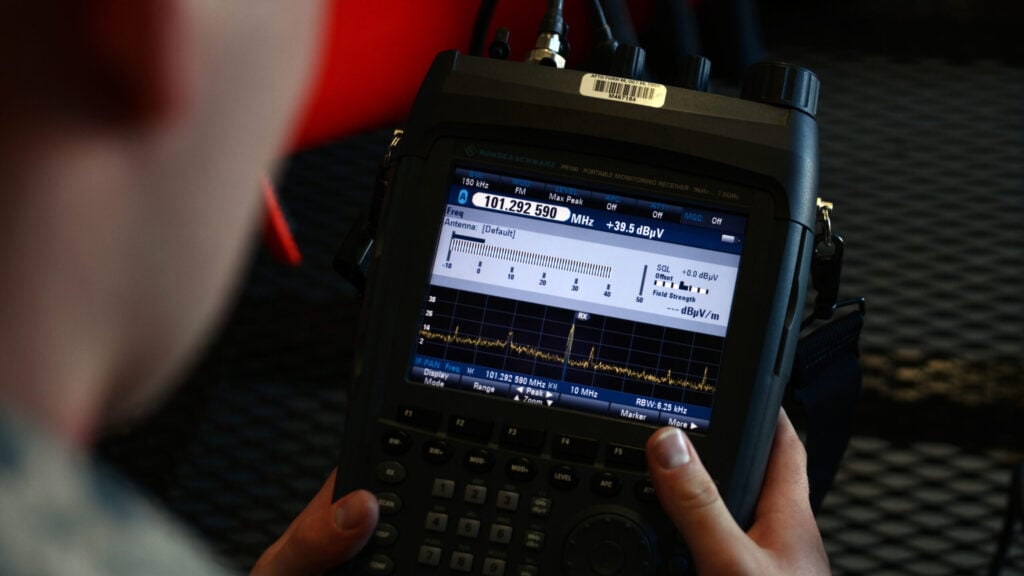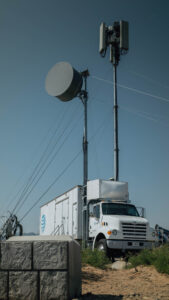
Air Force Staff Sgt. Geoffery Smith, 20th Communications Squadron installation spectrum manager, views the display on a radio spectrum analyzer at Shaw Air Force Base, S.C., Jan. 13, 2017. (Air Force photo by Airman 1st Class Kathryn R.C. Reaves)
WASHINGTON: The first prototype software “brain” being developed by Peraton Labs under a new Defense Department contract will be used to efficiently manage bandwidth — including 5G wireless — for airborne training, by pinpointing interference and automatically switching radio channels to available frequencies.
However, the end goal of the effort, called Operational Spectrum Comprehension, Analytics, and Response (OSCAR), is to develop an automated, near real-time spectrum management capability that can be moved into the field by multiple services for the Pentagon’s Joint All Domain Command and Control (JADC2) initiative.
“OSCAR has been used for the largely for the airborne flight training mission and also for the testing mission right now, but the aim of OSCAR is to evolve eventually into a solution that can be used in the battlefield for JADC2,” said Sunil Samtani, vice president, network systems at Peraton Labs, which is the applied research arm of Virginia-based defense tech giant Peraton.
The concept is to use artificial intelligence and machine learning to develop software that can go beyond current systems that simply forward plan for wireless bandwidth, Samtani explained in an interview with Breaking Defense today. OSCAR instead will allow both up-front planning and enable communications networks to almost instantaneously detect enemy jamming (or non-intentional interference from friendly forces) and re-route users to open channels — all without requiring a human operator to flip a switch.

An AT&T mobile 5G antenna is being used to provide 5G connectivity to participants of the Advanced Battle Management Systems (ABMS) Onramp 2 at White Sands Missile Range, New Mexico on Aug. 27, 2020. (U.S. Air Force photo by SSgt Charlye Alonso)
While at the moment OSCAR is being implemented by the Navy’s Naval Information Warfare Center, Peraton sees use cases for all the military services, Samtani said. The company already is working with the Army on a related project, and participated in the Project Convergence 21 experiment, he said, with plans to do so again next year.
Similarly, Samtani said Peraton has been involved in Air Force JADC2 related efforts, and is “applying” for a contract under the Advanced Battle Management System (ABMS) program.
While the company hasn’t yet had any discussions with Space Force, OSCAR will certainly have applicability to that service’s spectrum management needs, he added. “I believe OSCAR translates very well into the space mission,” he said.
The new contract, announced by Peraton Tuesday, was issued under DOD’s Spectrum Access Research & Development Program (SAR&DP) through DoD’s National Spectrum Consortium. The Other Transaction Authority (OTA) award is worth up to $18 million over a three-year period.
The National Spectrum Consortium was set up by DoD in 2015 to foster collaboration among with industry and academia to develop tech needed to enable widespread military and commercial access to and use of the electromagnetic spectrum for 5G communications. It currently has some 400 member organizations.
The Office of the Undersecretary of Defense for Research and Engineering (OUSDR&E) published the OSCAR request for prototype proposal (RPP) in April as part of the overarching Spectrum Forward OTA issued to the consortium in December 2020, with a total potential value of $2.5 billion over five years. The program is the third RPP under the SAR&DP effort.
OSCAR’s goal “is to provide advanced spectrum management capabilities to the incumbent systems in the AWS-3 bands; however, this prototype will be applicable to all spectrum being managed on range,” explained an April 26 consortium press release.
AWS stands for Advanced Wireless Services, and is a wireless telecommunications radio frequency spectrum band used for mobile, voice and data services, video, and messaging. AWS-3 covers frequency bands 1695-1710 MHz, 1755-1780 MHz and 2155-2180 MHz.
Peraton’s OSCAR prototype includes not just the software algorithms, but a graphical user interface — a “dashboard,” explained Samtani — and a sensor network. Peraton is using a suite of low-cost, commercially available RF sensors, he noted, but the OSCAR “brain” is designed to work with any type of sensor so it can be easily integrated into multi-service networks.
“We are going to build a capability that is not just unique to the use case that we are building it for,” he said.






















